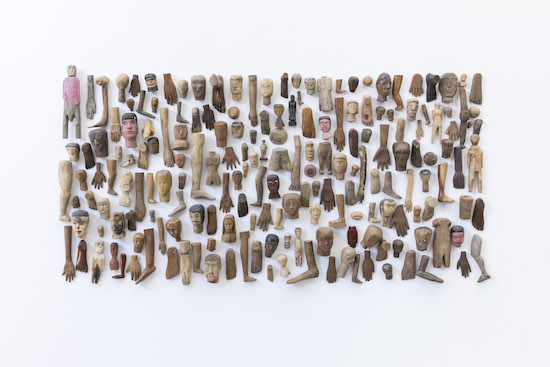Installation view of Trees, Fondation Cartier pour líart contemporain, 2019, Paris.
Photo: Thibaut Voisin
A month after Nous Les Arbres (‘We the Trees’) opened at the Cartier Foundation for Contemporary Art in Paris this summer, the Amazon rainforest was making headlines with apocalyptic footage of raging fires sweeping across a southern swathe of the basin. Impotent cries concerning an unprecedented rise in rates of deforestation, of the ‘lungs of the world’ facing imminent extinction, of the catastrophic destruction of habitat and of the rights of indigenous people, have now faded in their urgency, just as the global climate crisis has given way to a narrower focus on the activities of climate activists, at least when it comes to the dominant media narrative.
Several Brazilian and Paraguayan artists, including indigenous artists who live in the Amazon, have contributed to this ambitious exhibition, which naturally touches on the issues above. But its focus is wider, exploring our emotional attachment to trees and in what ways they continue to inform our imaginations; how trees shape our urban environments and how our urban environments are shaped in turn; how trees possess a form of ‘sensory intelligence’ that makes them react to imminent danger, for instance, by producing toxins to harm animal predators; and how trees and humans live in symbiosis, even through our destructive exploitation, even though we might well ask for how long. In short, it’s a sometimes sober, often joyful celebration of trees and not only is its sweep global, but it runs across several art-science disciplines.
A huge two-tiered ‘table-herbarium’ features a sturdy tree planted in its centre, for what would any exposition of the tree be without the real thing taking centre stage. Arranged neatly on the table surrounding it are various plant specimens, including rock and bark lichen, while on the tier below are underwater specimens of plants, bones and shells. It’s the work of Brazilian artist Luiz Zerbini, whose monumental, strikingly colourful paintings and delicate monoprints also dominate the sprawling ground floor space (the exhibition continues on the basement floor).
Zerbini’s paintings depict fantastical urban jungles, in the literal sense, where luscious foliage encroaches on urban domesticity divested of human presence. There’s an emphasis on textures and patterns, creating a collage-like, mildly psychedelic effect. The sultry, heady atmosphere is also suggested by the idea of nature running rampant, perhaps even slowly reclaiming its dominance in a post civilisation, Ballardian world.
Meanwhile, the black and white photographs of Sebastián Mejía document the palm trees of Chile’s capital, Santiago. The trees predate the city’s industrial development and, to often comic effect, they appear in the most unexpected places. We see how the city’s urban planners have accommodated the palm trees by simply building around them. A gas station, for example, has a palm growing through its roof, its abundant foliage bursting above the steel canopy. They’ve become an idiosyncratic feature of the Chilean city, and like Zerbini’s paintings, denote a tale of hardy survival.

Installation view of Trees, Fondation Cartier pour líart contemporain, 2019, Paris.
Photo: Thibaut Voisin
Everywhere there are delicate, often meticulously detailed drawings and paintings of trees, copses and tall forests. Especially striking are Italian architect and design duo Cesare Leonardi and Franca Stagi, who’ve devoted a decade to carefully observing and recording different species of urban trees throughout the seasons. Their work is characterised by an impressive precision and is clearly evidence of deep observation and study.
A more conceptual approach might be that of the Colombian artist Johann Callé, whose greyscale silhouettes of large trees printed over several taped together sheets of paper is, in fact, created by typewritten letters. Here she has transcribed onto old legal papers the Ley de Tierras (Land Law), which protects the rights of displaced persons who make a subsistence living from the land. The law allows them to claim ownership of land by declaring the trees they have planted there.

Installation view of Trees, Fondation Cartier pour líart contemporain, 2019, Paris.
Photo: Thibaut Voisin
American artist Charles Gaines is even more methodical in his approach. Starting from photographs, he composes layered silhouettes of trees onto graph paper using a combination of numbered squares which apparently index the directions of the branches from the trunk. If the mind boggles, the results are awfully pretty nonetheless. Other artists deploy a much looser, more folklorish aesthetic in their homage to trees.
With dozens of artists and so many exhibits, there’s a lot to digest, but Trees is, among so many other things, gloriously visually seductive, although the single work that seems to summarise and characterise the whole exhibition is not in itself particularly visually enticing. Raymond Depardon and Claudine Nougaret’s film Mon Arbre “gives a voice to the men and women who are surrounded by them, cherish them, observe them, defend them, care for them, admire them”, as well as those “who are a little tired of living with them.”
The film offers a series of snapshot portraits of individuals, including the botanist Francis Hallé, talking with often eccentric abandon about their relationship to their favourite tree – that is, a particular tree in a particular place in perhaps their favourite patch of land in the whole world, rather than a specimen of tree they may have seen in a book. It’s a charming idea and very lovingly executed, while the stories themselves, consisting of little more than anecdotes or expressions of love, are revealing, intimate and absorbing. And if this won’t make you hug a tree, then I don’t know what will. Go and discover the world of trees.
Nous Les Arbres is at the Fondation Cartier, Paris, until 5 January, 2020


